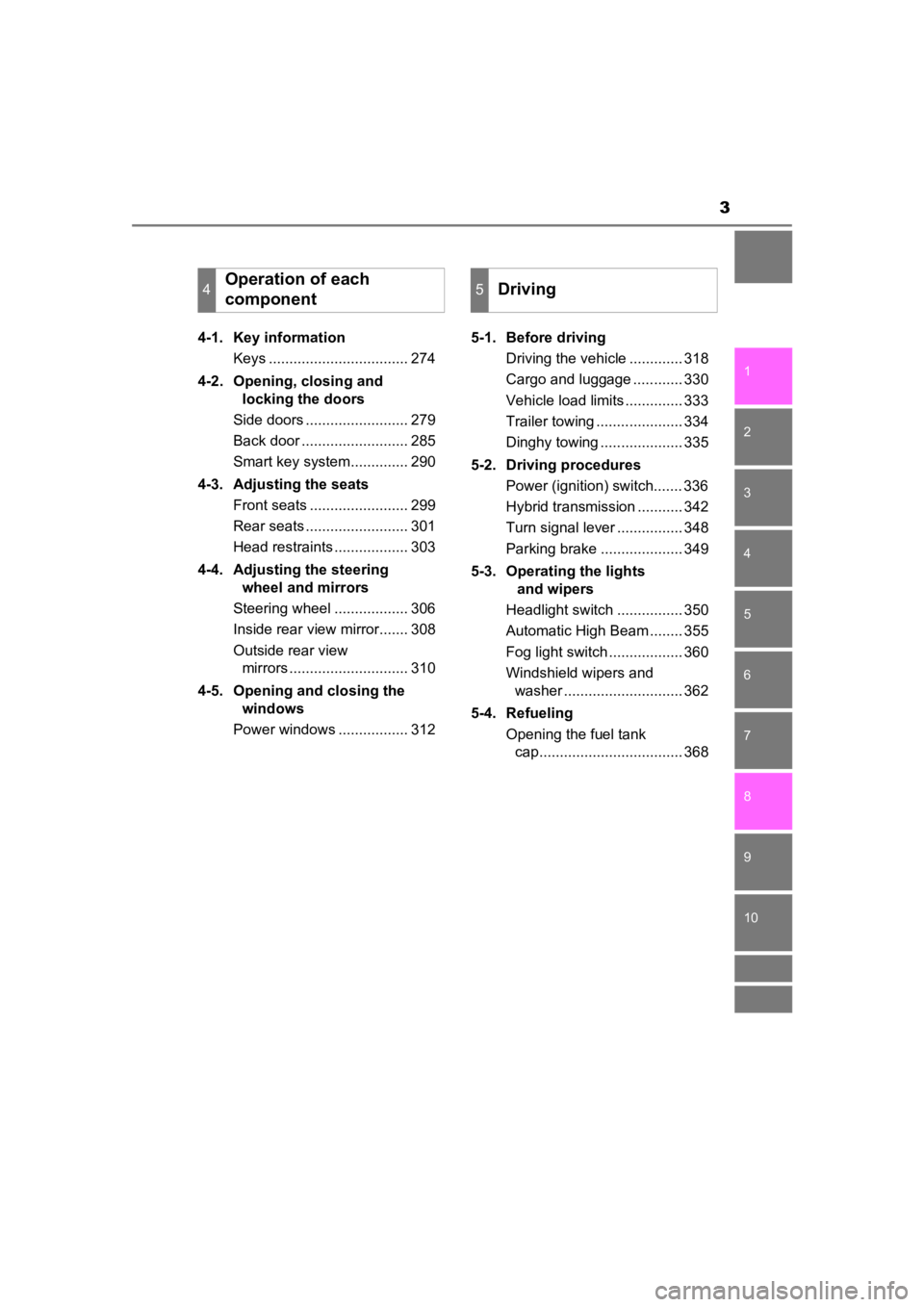2020 TOYOTA PRIUS PRIME brake
[x] Cancel search: brakePage 3 of 792

3
1
9 8
7
6 4 3
2
PRIUS PRIME_OM_OM47C77U_(U)
10
5
4-1. Key informationKeys .................................. 274
4-2. Opening, closing and locking the doors
Side doors ......................... 279
Back door .......................... 285
Smart key system.............. 290
4-3. Adjusting the seats Front seats ........................ 299
Rear seats ......................... 301
Head restraints .................. 303
4-4. Adjusting the steering wheel and mirrors
Steering wheel .................. 306
Inside rear view mirror....... 308
Outside rear view mirrors ............................. 310
4-5. Opening and closing the windows
Power windows ................. 312 5-1. Before driving
Driving the vehicle ............. 318
Cargo and luggage ............ 330
Vehicle load limits .............. 333
Trailer towing ..................... 334
Dinghy towing .................... 335
5-2. Driving procedures Power (ignition) switch....... 336
Hybrid transmission ........... 342
Turn signal lever ................ 348
Parking brake .................... 349
5-3. Operating the lights and wipers
Headlight switch ................ 350
Automatic High Beam ........ 355
Fog light switch .................. 360
Windshield wipers and washer ............................. 362
5-4. Refueling Opening the fuel tank cap................................... 368
4Operation of each
component5Driving
Page 4 of 792

TABLE OF CONTENTS4
PRIUS PRIME_OM_OM47C77U_(U)5-5. Using the driving support
systems
Toyota Safety Sense P ..... 373
PCS (Pre-Collision System) ........................... 381
LDA (Lane Departure Alert with steering
control) ............................ 393
Dynamic radar cruise control with full-speed
range ............................... 403
Driving mode select switch .............................. 419
BSM (Blind Spot Monitor) ........ 421
• The Blind Spot Monitor
function ......................... 425
• The Rear Cross Traffic Alert function ................. 428
Intuitive parking assist ....... 433
Parking Support Brake function ........................... 443
S-APGS (Simple Advanced Parking
Guidance System) .......... 455
Driving assist systems....... 489
5-6. Driving tips Winter driving tips.............. 495 6-1. Using the air conditioning
system and defogger
Automatic air conditioning system (vehicles with
7-inch display) ................. 500
Automatic air conditioning system (vehicles with
11.6-inch display) ............ 511
Remote Air Conditioning System ............................ 522
Heated steering wheel/ seat heaters..................... 526
6-2. Using the interior lights Interior lights list................. 528• Front interior light .......... 529
• Front personal lights ...... 529
• Rear interior light ........... 530
6-3. Using the storage features List of storage features ...... 531• Glove box ...................... 532
• Console box .................. 532
• Cup holders ................... 533
• Bottle holders/door pockets.................. 534
• Auxiliary boxes .............. 535
• Seat back pockets ......... 535
Luggage compartment features ........................... 536
6Interior features
Page 9 of 792

PRIUS PRIME_OM_OM47C77U_(U)
9
The installation of a mobile two-way radio system in your vehicle could affect
electronic systems such as:
● Hybrid system
● Multiport fuel injection system/sequential multiport fuel injection system
● Toyota Safety Sense P
● Anti-lock brake system
● SRS airbag system
● Seat belt pretensioner system
Be sure to check with your Toyota dealer for precautionary meas ures or spe-
cial instructions regarding instal lation of a mobile two-way radio system.
High voltage parts and cables on the hybrid vehicles emit appro ximately the
same amount of electromagnetic waves as the conventional gasoli ne pow-
ered vehicles or home electronic appliances despite of their el ectromagnetic
shielding.
Unwanted noise may occur in the reception of the mobile two-way radio.
Installation of a mobile two-way radio system
Page 10 of 792

10
PRIUS PRIME_OM_OM47C77U_(U)The vehicle is equipped with sophisticated computers that will
record certain
data, such as:
The recorded data varies according to the vehicle grade level and options
with which it is equipped
These computers do not record conversations or sounds, and only record
images outside of the vehicle in certain situations.
• Engine speed/Electric motor speed (traction motor speed)
• Accelerator status
• Brake status
• Vehicle speed
• Operation status of the driving assist systems, such as the AB S and pre-
collision system
• Images from the camera (available only when certain safety sys tems are
activated, which varies depending on the vehicle specifications).
• Hybrid battery (traction battery) status
●Data Transmission
Your vehicle may transmit the data recorded in these computers to Toyota
without notification to you.
●Data usage
Toyota may use the data recorded in these computers to diagnose malfunc-
tions, conduct research and development, and improve quality.
Toyota will not disclose the recorded data to a third party exc ept:
• With the consent of the vehicle owner or with the consent of the lessee if the vehicle is leased
• In response to an official request by the police, a court of l aw or a govern-
ment agency
• For use by Toyota in a lawsuit.
• For research purposes where the data is not tied to a specific vehicle or
vehicle owner
●Recorded image information can be erased by your Toyota dealer.
The image recording function can be disabled. However, if the f unction is
disabled, data from when the pre-collision system operates will not be avail-
able.
●To learn more about the vehicle data collected, used and shared by Toy-
ota, please visit www.toyota.com/privacyvts/
.
If your Toyota has Safety Connect and if you have subscribed to those ser-
vices, please refer to the Safety Connect Telematics Subscription Service
Agreement for information on data collected and its usage.
To learn more about the vehicle data collected, used and shared by Toyota,
please visit www.toyota.com/privacyvts/
.
Vehicle data recording
Usage of data collected thr ough Safety Connect (U.S.mainland
only)
Page 11 of 792

PRIUS PRIME_OM_OM47C77U_(U)
11
This vehicle is equipped with an event data recorder (EDR). The main pur-
pose of an EDR is to record, in certain crash or near crash-lik e situations,
such as an air bag deployment or hitting a road obstacle, data that will assist
in understanding how a vehicle’s systems performed. The EDR is designed to
record data related to vehicle dynamics and safety systems for a short period
of time, typically 30 seconds or less.
The EDR in this vehicle is designed to record such data as:
• How various systems in your vehicle were operating;
• Whether or not the driver and passenger safety belts were buckled/fas-tened;
• How far (if at all) the driver was depressing the accelerator and/or brake pedal; and,
• How fast the vehicle was traveling.
These data can help provide a better understanding of the circu mstances in
which crashes and injuries occur.
NOTE: EDR data are recorded by your vehicle only if a non-trivi al crash situ-
ation occurs; no data are recorded by the EDR under normal driv ing condi-
tions and no personal data (e.g., name, gender, age, and crash location) are
recorded. However, other parties, such as law enforcement, could combine
the EDR data with the type of personally identifying data routi nely acquired
during a crash investigation.
To read data recorded by an EDR, special equipment is required, and access
to the vehicle or the EDR is needed. In addition to the vehicle manufacturer,
other parties, such as law enforcement, that have the special e quipment, can
read the information if they have access to the vehicle or the EDR.
●Disclosure of the EDR data
Toyota will not disclose the data recorded in an EDR to a third party except
when:
• An agreement from the vehicle’s owner (or the lessee for a lea sed vehi-
cle) is obtained
• In response to an official request by the police, a court of l aw or a govern-
ment agency
• For use by Toyota in a lawsuit
However, if necessary, Toyota may:
• Use the data for research on vehicle safety performance
• Disclose the data to a third party for research purposes witho ut disclosing
information about the specific vehicle or vehicle owner
Event data recorder
Page 19 of 792

19Pictorial index
PRIUS PRIME_OM_OM47C77U_(U)Multi-information display . . . . . . . . . . . . . . . . . . . . . . . . . . . P. 218
Display . . . . . . . . . . . . . . . . . . . . . . . . . . . . . . . . . . . . . . . . . . . P. 218
Energy monitor . . . . . . . . . . . . . . . . . . . . . . . . . . . . . . . . . . . . P. 221
When the warning messages are displayed . . . . . . . . . . . . . . P. 672
Parking brake . . . . . . . . . . . . . . . . . . . . . . . . . . . . . . . . . . . . . P. 349
Applying/releasing . . . . . . . . . . . . . . . . . . . . . . . . . . . . . . . . . . P. 349
Precautions against winter season . . . . . . . . . . . . . . . . . . . . . P. 495
Warning buzzer . . . . . . . . . . . . . . . . . . . . . . . .
. . . . . . . . . . . . P. 349
Turn signal lever . . . . . . . . . . . . . . . . . . . . . . . . . . . . . . . . . . P. 348
Headlight switch . . . . . . . . . . . . . . . . . . . . . . . . . . . . . . . . . . P. 350
Headlights/parking lights/tail lights/
daytime running lights . . . . . . . . . . . . . . . . . . . . . . . . . . . . . . . P. 350
Fog lights
*1 . . . . . . . . . . . . . . . . . . . . . . . . . . . . . . . . . . . . . . . P. 360
Windshield wipers and washer switch . . . . . . . . . . . . . . . . P. 362
Usage . . . . . . . . . . . . . . . . . . . . . . . . . . . . . . . . . . . . . . . . . . . P. 362
Adding washer fluid . . . . . . . . . . . . . . . . . . . . . . . . . . . . . . . . . P. 600
Emergency flasher switch . . . . . . . . . . . . . . . . . . . . . . . . . . P. 652
Fuel filler door opener . . . . . . . . . . . . . . . . . . . . . . . . . . . . . . P. 370
Hood lock release lever. . . . . . . . . . . . . . . . . . . . . . . . . . . . . P. 585
Tilt and telescopic steering lock release lever . . . . . . . . . . P. 306
Air conditioning system . . . . . . . . . . . . . . . . . . . . . . . . P. 500, 511
Usage . . . . . . . . . . . . . . . . . . . . . . . . . . . . . . . . . . . . . . . P. 500, 512
Rear window defogger . . . . . . . . . . . . . . . . . . . . . . . . . . . P. 504, 515
Audio system
*2
*1: If equipped
*2: Refer to “NAVIGATION SYSTEM OWNER’S MANUAL” or “MULTIMEDIA OWNER’S MANUAL”.
5
6
7
8
9
10
11
12
13
14
Page 94 of 792

94
PRIUS PRIME_OM_OM47C77U_(U)
2-1. Plug-in hybrid system
■Regenerative braking
In the following situations, kinetic energy is converted to electric energy and
deceleration force can be obtained in conjunction with the rech arging of the
hybrid battery (traction battery).
● The accelerator pedal is released while driving with the shift position in D or
B.
● The brake pedal is depressed while driving with the shift posit ion in D or B.
■ EV driving range
●The EV driving range is displayed on the multi-information disp lay etc.
( P. 212, 228, 235, 252)
● The EV driving range changes in accordance with the charge status of the
hybrid battery (traction battery), the speed of the vehicle, et c.
● Even if there is enough charge remaining in the hybrid battery (traction bat-
tery), EV driving may be canceled and both gasoline engine and electric
motor are used depending on the situation. ( P. 95)
■ After EV mode has switched to HV mode due to low hybrid battery (trac-
tion battery) charge
If the hybrid battery (traction battery) is regenerated by driving continuously
down a long slope, the EV driving range etc. will be displayed on the multi-
information display and EV mode will be automatically switched to.
If EV mode is not switched to even though EV driving range is b eing dis-
played, EV mode can be switched to by pressing the EV/HV mode selection
switch.
■ Refilling fuel
Plug-in hybrid vehicles can be driven using electricity charged from an exter-
nal power source. However, as the gasoline engine is used depending on the
situation even if in EV mode, and the gasoline engine is provided on board as
a power source for driving in HV mode, it is needed to refuelin g the vehicle.
Check the fuel amount and refill immediately when the fuel level becomes
low. ( P. 368)
Page 96 of 792

96
PRIUS PRIME_OM_OM47C77U_(U)
2-1. Plug-in hybrid system
■If the vehicle is not used for a long time
●The 12-volt battery may discharge. In this event, charge the 12 -volt battery.
( P. 595)
In order to prevent the hybrid battery (traction battery) from becoming
extremely low in charge, charge the hybrid battery (traction ba ttery) from
external power source or start the hybrid system at least once every 2 or 3
months, and turn the power switch off after the gasoline engine has
stopped automatically. (If the gasoline engine does not start up even after
approximately 10 seconds have pass ed since the “READY” indicator came
on, the power switch can be turned to off without any further action.)
● When the vehicle is left with the charging cable connected, the electricity
consumption amount of the 12-volt battery increases due to cont rols, such
as the system checking, operating. When the charging cable is n ot needed,
immediately remove it from the vehicle.
■ Sounds and vibrations sp ecific to a hybrid vehicle
There may be no engine sound or vibration even though the vehic le is able to
move with the “READY” indicator is illuminated. For safety, app ly the parking
brake and make sure to shift the shift position to P when parke d.
The following sounds or vibrations may occur when the hybrid sy stem is
operating and are not a malfunction.
● Motor sounds may be heard from the engine compartment.
● Sounds may be heard from the hybrid battery (traction battery) when the
hybrid system starts or stops.
● Relay operating sounds such as a snap or soft clank will be emi tted from the
hybrid battery (traction battery), behind the rear seats, when the hybrid sys-
tem is started or stopped.
● Sounds from the hybrid system may be heard when the back door is open.
● Sounds may be heard from the transmission when the gasoline engine
starts or stops, when driving at low speeds, or during idling.
● Engine sounds may be heard when accelerating sharply.
● Sounds may be heard due to regenerative braking when the brake pedal is
depressed or as the accelerator pedal is released.
● Vibration may be felt when the gasoline engine starts or stops.
● Cooling fan sounds may be heard from the air intake vent. ( P. 99)
■ Vehicle proximity notification system
In the following cases, the vehicle proximity notification syst em may be diffi-
cult for surrounding people to hear.
● In very noisy areas
● In the wind or the rain
Also, as the vehicle proximity notification system is installed on the front of
the vehicle, it may be more difficult to hear from the rear of the vehicle com-
pared to the front.